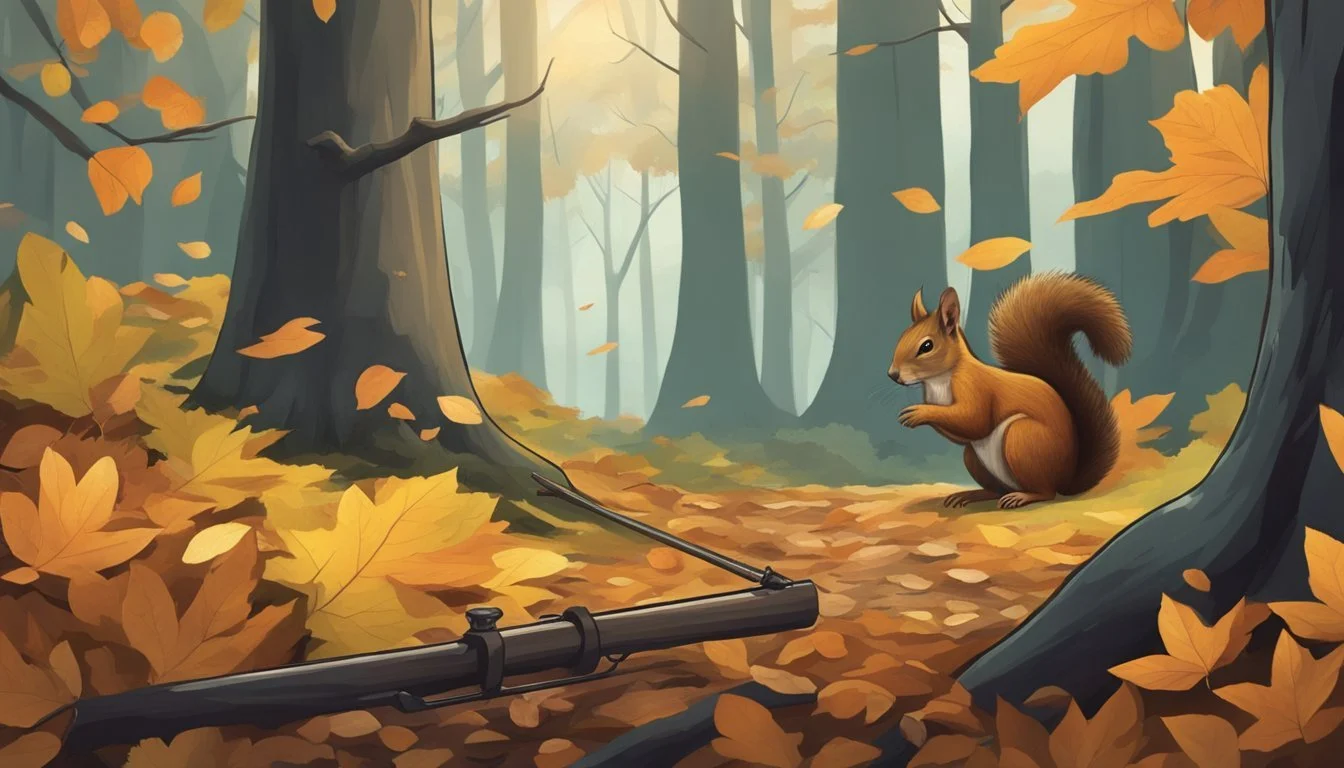Squirrel Hunting Seasons
Guidelines and Regulations Across States
This Article is Part of Our Guide on Hunting Seasons for Over 70 Common Game Species
Squirrel hunting is a popular outdoor activity that can be pursued across multiple states in the United States. It involves tracking and harvesting squirrels for their meat and is typically practiced during designated hunting seasons. These seasons are established by wildlife conservation authorities and are designed to maintain healthy squirrel populations while providing hunting opportunities.
Each state has specific regulations governing squirrel hunting, including season dates, bag limits, and permissible methods of harvest. For instance, in Eastern Texas, the general season runs from October 1 through February 25, and again from May 1 through May 31, allowing for both fall and spring hunting opportunities.
Hunters engaged in this pastime must be well-versed in species identification, as regulations may differ among various squirrel types, such as the Eastern Fox Squirrel or other local species. Adherence to daily bag limits—often ranging from four to six squirrels per day—is essential to ensure sustainable hunting practices. The framing of these regulations helps to preserve ecological balance and provide continuous hunting action throughout the permissible months.
Understanding Squirrel Behavior
To effectively hunt squirrels, it's crucial to comprehend their foraging behavior, habitat preferences, and signs of their presence, in order to determine the best hunting times and strategies tailored to their specific species.
Foraging Patterns
Squirrels are primarily active during dawn and dusk, a behavior known as crepuscular activity. Throughout these times, they are busy foraging for a variety of foods such as acorns, seeds, berries, and mushrooms. Understanding their foraging patterns helps in anticipating their movements during hunting seasons.
Habitats and Activity
Squirrels, like the widely spread gray squirrel and the bushy-tailed fox squirrel, prefer wooded areas rich in sources of nuts, particularly oak trees. Their activities range from foraging on the ground to gliding between tree canopies. Identifying areas with vast nesting resources increases chances of locating squirrels.
Identifying Signs of Squirrels
Capturing squirrels requires knowledge of their presence. Look for tracks, freshly cut tree buds, and nests or "dreys" constructed in the forks of trees. Listening for their chatter or the sound of their feeding can also lead you to their location.
Optimal Hunting Times
The prime times to hunt are during the squirrels' most active periods which are early morning and late evening. Targeting them during their foraging times increases the likelihood of a successful hunt.
Diet and Nutritional Habits
Squirrels adapt their diet according to what’s available seasonally, feeding heavily on acorns, seeds, and berries during late summer and fall. Utilizing this knowledge guides hunters to areas where these foods are abundant.
Squirrel Species Overview
Squirrel species vary by region, including the adaptable gray squirrel, the more elusive red squirrel, the larger fox squirrel, and the burrowing ground squirrel. Each species has unique traits and behaviors that affect how one might approach the hunt.
Preparation For Squirrel Hunting
Proper preparation is critical for a successful squirrel hunting venture. It involves selecting the right gear, understanding safety protocols, and respecting wildlife conservation principles.
Choosing the Right Gear
The foundation of effective squirrel hunting starts with the gear. Hunters should opt for lightweight camouflage clothing to blend into the environment. Durable boots are essential for navigating woodland terrain. Essential gear includes a backpack, binoculars for spotting, and weather-appropriate clothing.
Selecting Ammunition
For shotguns, #6 pellets are a standard choice, providing an effective range without excessive damage to the meat. When using a rimfire rifle, a .22 caliber with a magazine and proper chamber size is preferred for precision. Air rifles are also popular, offering a quieter alternative.
Scouting and Strategy
Prior to the hunt, scouting the area for squirrel activity is beneficial. Look for signs like tracks, food sources, such as acorns and hickory nuts, and listen for the sound of squirrels moving. Early morning or late afternoon are prime times when squirrels are most active.
Safety Measures
Wearing hunter orange is advisable for visibility to other hunters. Follow safe shooting practices, which include identifying your target and what lies beyond it. Always handle firearms with care to prevent accidents.
Hunting Ethics and Conservation
Sustainable practices, such as adhering to bag limits and following conservation orders, help maintain healthy squirrel populations. Respect for the animal and the environment should guide all hunting activities.
Using Hunting Calls
Squirrel calls can be employed to mimic the sounds of squirrels and attract them. This technique requires practice to master, but it can be an effective method to lure in squirrels during a hunt.
Practicing Shooting Skills
Regular target practice improves accuracy, whether with a shotgun, air rifle, rimfire rifle, or archery equipment. It increases the chance of a clean shot, which is both ethical and preserves the quality of the game.
Hunting Licenses and Education
Secure the necessary hunting licenses, which may involve completing a hunter education course. Understand the regulations and conservation orders for light geese as an example of wildlife management and adapt those principles to squirrel hunting.
Land Access Permissions
Gain permission to hunt on private lands or familiarize yourself with the rules governing the use of public land. Compliance with this shows respect for property owners and the stewardship of public resources.
Legal and Seasonal Considerations
When planning to hunt squirrels, understanding the legal framework and seasonal timings is crucial. This involves being aware of state-specific regulations, season dates, daily bag limits, and the legal distinctions between hunting on different types of land.
Understanding State Regulations
Each state has its own set of regulations that govern squirrel hunting. These rules define everything from whether hunters can use dogs to the types of firearms allowed. State wildlife agencies provide these regulations, which hunters must review and understand prior to their hunting outings.
Season Dates and Bag Limits
The hunting seasons for squirrels generally fall within:
Fall season: Early to mid-fall, which varies by state.
Spring season: Specific dates that also vary by state.
Bag limits are set to control the number of squirrels a hunter can harvest in a day. For example, some areas may allow a daily bag limit of four to six squirrels.
Species-Specific Seasons
Different species of squirrels may have different seasons. The Eastern Fox Squirrel (Sciurus niger), one of the commonly hunted species, has its specific season dates, which could differ from those for other squirrel species.
Hunting on Private vs Public Lands
Hunters must distinguish between private and public lands:
Private lands: Permission is often required from the landowner.
Public land: May have more restrictive season dates or bag limits.
Compliance with these guidelines ensures sustainable hunting practices and respects property rights.
Additional Considerations
Hunters should be mindful of:
Possession limits: The number of squirrels that one can legally possess at a time.
Conservation orders for light geese or other animals: Ensure squirrel hunting does not interfere with these orders.
Compliance With Hunting Laws
Consistently following hunting laws maintains the tradition and ethics of hunting. This includes adherence to:
Seasonal restrictions
Daily and possession bag limits
Legal hunting methods and equipment
It is imperative to check-in with the local wildlife conservation authorities for the latest information before embarking on a squirrel hunting trip.
Squirrel Hunting Methods
Squirrel hunting requires a range of tactics suited to the quarry's arboreal lifestyle and acute senses. Different methods can significantly increase success in diverse habitats and seasons.
Still-Hunting Technique
The still-hunting method involves quietly waiting in an area with high squirrel activity, usually near food sources like mast trees. Hunters remain motionless and use natural cover to blend into the environment.
Stalking Squirrels
Stalking entails slow, deliberate movement through a squirrel's habitat. Hunters track squirrels by looking for signs like chewed nuts and then advance quietly to get within shooting range.
Using Hunting Dogs
Hunters often employ dogs specialized in treeing squirrels, such as feists or curs. The dogs scent and chase squirrels up trees, making it easier for hunters to spot the game.
Trapping as an Alternative
Trapping is a viable alternative for squirrel hunting, using live traps around known squirrel routes and food sources. Traps must be checked frequently in adherence to local wildlife regulations.
Attracting Squirrels for Hunting
Using squirrel calls and decoys can lure squirrels into the open. Hunters mimic squirrel noises or distress calls to pique curiosity and bring squirrels closer.
Small Game Hunting Tactics
Squirrels, classified as small game, often share their environment with raccoons, opossums, and crows. A hunter skilled in small game tactics adjusts strategies based on the targeted species' behavioral patterns.
Archery Hunting
Hunters utilize bows or crossbows for a challenging squirrel hunt. Archery demands precision and practice, using arrows specifically designed for small game to ensure a humane harvest.
Firearm Selection and Use
Shotguns, especially 20-gauge, and rimfire rifles are preferred firearms for squirrel hunting. Hunters choose their firearm based on the desired range and the density of the hunting grounds.
Treed Hunting
When a squirrel is 'treed' or cornered in a tree, hunters use patient observation to wait for the squirrel to move into a position where it can be safely and ethically shot.
After the Hunt
After securing a squirrel during the hunting season, the next steps involve processing your game, exploring culinary opportunities, considering trophy preservation, and ethically managing remains.
Processing and Cleaning Your Harvest
Step-by-Step Cleaning Guide:
Make Initial Cuts: Start by making a cut from the hind legs to the tail.
Separate the Hide: Pull the hide apart from the body, sever at the head, and remove the hide entirely.
Remove Extremities: Detach the feet, head, and tail.
Eviscerate: Carefully remove the internal organs, ensuring not to puncture them to avoid spoiling the meat.
Rinse: Thoroughly rinse the carcass with cold water.
Storage Tips:
Refrigerate the clean squirrel meat at 34-40°F (1-4°C) if not used immediately.
For longer storage, vacuum seal and freeze, ensuring it’s labeled with the date of processing.
Cooking Squirrel Meat
Squirrel meat is known for its nutty flavor and can be prepared using various cooking methods.
Popular Cooking Methods:
Braising: For tender and flavorful meat, slow cook with a mixture of vegetables and herbs.
Frying: Breaded and fried squirrel pieces are a classic preparation in Southern cuisine.
Stewing: Incorporate into stews or soups to extract the rich flavor.
Quick Recipe Ideas:
Squirrel Dumplings: Stew meat until tender before adding dumplings.
Barbecue Squirrel: Baste with your favorite sauce and grill for a smoky taste.
Trophy and Taxidermy Options
For those who view squirrel hunting as a sport, preserving their trophy is an important consideration.
Full Body Mounts: Exhibit the hunt with a lifelike pose.
Skull Displays: Showcase the dentition of the squirrel, which is a unique keepsake for hunters.
Choosing a Taxidermist:
Look for professionals accredited by the National Taxidermists Association.
Ethical Disposal of Remains
After butchering, ethical practices in disposing of the remains are crucial for environmental conservation.
Best Practices:
Burying: Dispose of remnants deep enough to prevent scavenging and at a considerable distance from water sources.
Composting: Consider composting if local regulations allow, ensuring it’s away from living quarters due to the odor.
Note: Always adhere to state regulations and health guidelines when disposing of biological material.




